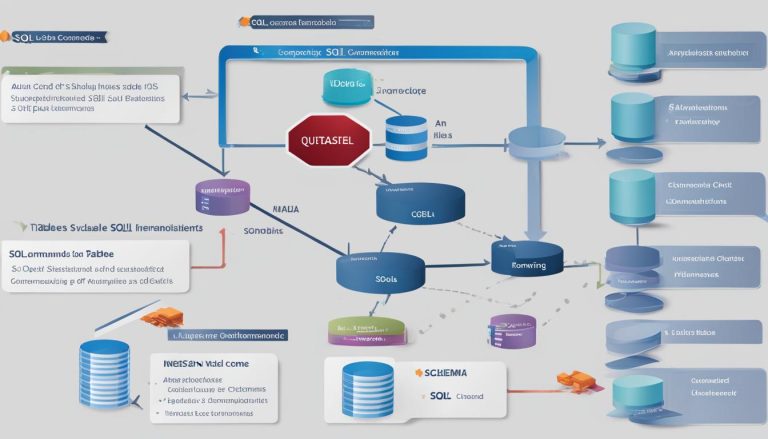Understanding What is a Query in Databases & Search
In the world of databases and search engines, queries play a vital role in retrieving information and performing various data manipulations. But what exactly is a query and how does it work? In this article, I will provide you with a comprehensive understanding of what a query is, its definition, and its meaning.
Key Takeaways:
- A query in databases and search engines is a formal request for information or data retrieval.
- There are different types of queries, including select queries for data retrieval and action queries for data manipulation.
- SQL (Structured Query Language) is the standard language used for querying databases.
- Queries can also extend beyond databases, encompassing web search queries and specific query functions in programming languages like JavaScript.
- Understanding queries is crucial for efficient data management, automation, and information retrieval in various systems.
Creating Different Types of Queries in Databases
In the world of databases, queries allow users to retrieve and manipulate data with ease. Let’s take a closer look at the different types of queries and how they are created.
Create a Select Query
A select query is one of the most commonly used queries in databases. It allows users to review data from specific fields in a table or multiple tables simultaneously. Users can also apply criteria to filter the data or display information based on certain conditions. To create a select query, you need to specify the table and the fields you want to retrieve data from.
Create a Parameter Query
Parameter queries prompt users to specify criteria or field values each time they run the query. These specified values are then used to create criteria for the query, allowing users to retrieve the desired data based on their inputs. Parameter queries are helpful when you want to create flexible and dynamic queries that can be tailored to different circumstances.
Create a Totals Query
Totals queries are used to group and summarize data, providing users with aggregated values or performing calculations at a more comprehensive level. These queries are particularly useful when you want to analyze and understand the overall picture of your data. To create a totals query, you need to specify the fields you want to group and the calculations you want to perform.
Create a Crosstab Query
Crosstab queries transform data into a cross-tabulated format, presenting summary information in a matrix-like structure. They allow users to analyze data across multiple dimensions, making it easier to identify trends and patterns. To create a crosstab query, you need to specify the row and column headings and the values you want to display in the matrix.
Create a Make Table Query
Make table queries are used to create new tables based on the selected data or the results of a query. These queries are handy when you want to isolate and store a specific set of data for further analysis or reporting purposes. To create a make table query, you need to specify the source table or query and the destination table where the new data will be stored.
Create an Append Query
Append queries add records to an existing table or combine data from multiple tables into a single table. These queries are useful when you want to consolidate data from various sources or when you need to update an existing table with new records. To create an append query, you need to specify the source tables or queries and the destination table where the new records will be added.
Create an Update Query
Update queries modify existing data in a table based on specified criteria. They allow users to make changes to multiple records simultaneously, saving time and effort. To create an update query, you need to specify the table you want to update, the fields you want to change, and the criteria that determine which records should be updated.
Create a Delete Query
Delete queries remove records from a table based on specified criteria. They are used to eliminate unnecessary or outdated data from a database, ensuring data integrity and maintaining database performance. To create a delete query, you need to specify the table you want to delete records from and the criteria that determine which records should be deleted.
By understanding how to create different types of queries, you can leverage the full power of databases to retrieve, manipulate, and manage your data effectively.
Understanding SQL Queries and Their Functionality
SQL queries play a vital role in retrieving and manipulating data from databases. One of the most commonly used SQL queries is the SELECT statement.
The SQL SELECT statement allows users to choose specific data from a database and return it to an application or result-set. This powerful query provides flexibility in filtering, sorting, and manipulating data to meet specific requirements.
When constructing an SQL query, it can be broken down into different sections for better organization and control. The FROM clause specifies the tables or views from which the data will be retrieved. The WHERE clause allows users to apply conditions to filter the data and retrieve only the relevant information. The ORDER BY clause sorts the data in ascending or descending order based on specified columns or expressions.
Query by Example
Query by example (QBE) is an alternative way to request information from a database without writing traditional query language code. Instead, users can provide sample data that matches the desired result, and the database system generates the appropriate query. This intuitive approach simplifies the querying process, particularly for users who may not be well-versed in SQL.
Query Parameters
Query parameters are placeholders used to pass values dynamically into SQL queries. By using query parameters, users can prompt for input or specify field values each time they execute the query. This ensures flexibility and enables the creation of dynamic and adaptable queries based on user input.
Query Folding
Query folding is an optimization technique employed in Power Query, Microsoft’s business intelligence platform. It involves transforming a user’s query steps into an optimized query statement that can improve performance. By minimizing unnecessary data retrieval and processing, query folding enhances efficiency and ensures faster execution of queries.
Additionally, Power Query allows for various data transformations using SQL queries or M Language. This feature empowers users to perform complex data mashups and transformations, enabling comprehensive data analysis and insights.
It’s important to note that while SQL is the standard query language for databases, different databases can have their own query languages, extensions, and functionalities. Familiarity with the specific query languages used in different database systems is essential for maximizing their potential.
Queries Beyond Databases: Web Search Queries and Other Examples
Web search queries are requests for information made by users on search engines like Google, Bing, or Yahoo. These queries are intended to find specific information or topics and are sorted by search engine algorithms.
JavaScript’s
1 | querySelector() |
method is used to find the first element that matches a specified CSS selector. It can also be used in combination with
1 | querySelectorAll() |
to return all matching elements.
Query errors can occur in various systems or platforms, such as Facebook, where users may encounter issues with their queries and receive error messages when trying to perform specific actions.
Other examples of queries include those related to database performance management systems, SQL Server Analysis Services (SSAS), Managed Information Base (MIB), CPU usage, relational databases, and database concurrency.

Examples of Common Query Errors in Facebook
| Error Code | Error Message | Possible Fix |
|---|---|---|
| 500 | Internal Server Error | Wait and try again later or contact Facebook support |
| 403 | Forbidden | Ensure you have the necessary permissions for the action you are trying to perform |
| 404 | Page Not Found | Double-check the URL or search for the page using different keywords |
| 400 | Bad Request | Review your input and make sure all required fields are filled correctly |
These examples demonstrate the potential issues users may encounter with their queries on Facebook and the steps they can take to resolve them.
Conclusion
Understanding queries is crucial in the world of databases and search engines. Queries empower users to retrieve information, perform data operations, automate tasks, and analyze data effectively. By mastering different types of queries, such as select queries, action queries, and totals queries, users can harness the full potential of databases.
SQL, the standard query language for databases, plays a pivotal role in query execution. However, it’s worth noting that various query languages cater to different systems and databases, offering unique features and functionalities. Having a comprehensive understanding of these query languages allows users to leverage their database systems optimally.
Web search queries provide a means for users to explore specific topics or retrieve information on the internet. By formulating thoughtful search queries, users can obtain accurate and relevant results from search engines like Google, Bing, or Yahoo.
Queries are not limited to databases and search engines; they extend to various contexts, including JavaScript programming and other specialized systems. Whether it’s retrieving elements using JavaScript’s querySelector(), troubleshooting query errors, or optimizing database performance, the diverse applications of queries offer invaluable capabilities in a range of domains. In summary, understanding queries is fundamental for efficient data retrieval and manipulation across databases, search engines, and programming languages.
FAQ
What is a query?
In the context of databases and search engines, a query is a formal request for information or data retrieval. It is a way for users to express their need for specific data or actions.
What types of queries can be created in databases?
There are various types of queries that can be created in databases, including select queries, parameter queries, totals queries, crosstab queries, make table queries, append queries, update queries, and delete queries.
How do I create a select query?
To create a select query, you specify the data you want to retrieve from one or more tables. You can also apply criteria to filter the data or display data based on certain conditions.
What is a parameter query?
A parameter query prompts users to specify criteria or field values each time they run the query. The specified values are then used to create criteria for the query.
What is a totals query?
A totals query is used to group and summarize data, allowing users to see aggregated values or perform calculations at a more comprehensive level.
What is a crosstab query?
A crosstab query transforms data into a cross-tabulated format, presenting summary information in a matrix-like structure.
How do I create a make table query?
To create a make table query, you select data from one or more tables, and a new table is created based on the selected data or results of the query.
What is an append query?
An append query is used to add records to an existing table or combine data from multiple tables into a single table.
How do I create an update query?
To create an update query, you specify the table you want to modify and the criteria that determine which records should be updated. The query then modifies the existing data in the table based on the specified criteria.
What is a delete query?
A delete query is used to remove records from a table based on specified criteria. It allows users to selectively delete records from a table.
What is an SQL query?
An SQL query, specifically a SELECT statement, allows users to choose and retrieve data from a database and return it to an application or result-set. SQL queries can also perform calculations, summarize data, and automate data management tasks.
What is query folding?
Query folding is the optimization technique used by Power Query in Microsoft’s business intelligence platform to generate efficient query statements and improve performance.
What are web search queries?
Web search queries are requests for information made by users on search engines like Google, Bing, or Yahoo. These queries help users find specific information or topics and are sorted by search engine algorithms.
How do I use JavaScript’s querySelector() method?
JavaScript’s querySelector() method is used to find the first element that matches a specified CSS selector. It can also be used in combination with querySelectorAll() to return all matching elements.
What are query errors?
Query errors can occur in various systems or platforms, such as Facebook. Users may encounter issues with their queries and receive error messages when trying to perform specific actions.
Are there other examples of queries beyond databases?
Yes, there are other examples of queries, including those related to database performance management systems, SQL Server Analysis Services (SSAS), Managed Information Base (MIB), CPU usage, relational databases, and database concurrency.
Why are queries important?
Queries are essential in databases and search engines as they allow users to retrieve information, perform operations on data, automate tasks, summarize data, and more. Understanding the different types of queries helps users utilize databases efficiently.
- About the Author
- Latest Posts
Mark is a senior content editor at Text-Center.com and has more than 20 years of experience with linux and windows operating systems. He also writes for Biteno.com






